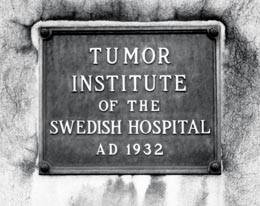On November 15, 1932, construction begins on Swedish Hospital's Tumor Institute building. Dr. Nils A. Johanson (1872-1946) had recently established the Tumor Institute at Swedish after returning from Europe, where he learned about the development of radiation treatments for cancer. Johanson models the institute after the Karolinska Institute and the Radiumhemmet in Stockholm, Sweden, which integrate cancer research with patient treatment. The Tumor Institute, renamed Swedish Cancer Institute in 1999, is the first of several ventures at Swedish that expand its scope and attract highly respected physicians to the hospital.
Radiation Therapy for Cancer
In 1928, Dr. Johanson attended an international cancer conference in London, at which he learned about new methods of treating cancer with X-ray radiation. Johanson also visited the Karolinska Institute and the Radiumhemmet in Stockholm. Both of these hospitals conducted research into radiation therapy and treated cancer patients. In 1932, Johanson established the Tumor Institute at Swedish based on this model of integrated research and treatment.
Seattle architect Carl F. Gould (1873-1939) designed the Tumor Institute building to accommodate a 16-foot-long X-ray tube with a 30-inch-diameter bulb. The three-story room housing the X-ray tube had three-foot-thick concrete walls, floor, and ceiling to contain the radiation. A local newspaper labeled the building "modernistic" in an article titled "$15,000 Room to House X-Ray at Local Hospital."
The X-ray tube was one of just three million-volt tubes in operation in the United States. The other two were at Mercy Hospital in Chicago and the California Institute of Technology. General Electric manufactured the tube in Schenectady, New York.
Attracted by the device's great power, University of Washington physicists sought to use the X-ray tube for academic research. The hospital and the university made an agreement allowing professors and graduate students to use the X-ray tube to conduct experiments. Beginning in 1934, physics professor Donald H. Loughridge studied where secondary radiation from X-rays went so he could determine how best to direct the beam. Also that year, his fellow physics professor Joseph E. Henderson began research on the effects of high voltage.
Dr. Charles B. Ward, who had recently studied cancer treatments in Europe, and Dr. Delbert H. Nickson (1890-1952), a Swedish Hospital pathologist, led the institute. It was the first treatment center west of the Mississippi River to do high-energy radiation therapy for cancer. In addition to the X-ray tube, the institute operated a radiation emanator.
Forerunner of the Modern Hospital Enterprise
Decades later, in 1988, Swedish Hospital's Executive Director, Allan Lobb, would identify the opening of the Tumor Institute as one of the keys to Swedish's success. In a Seattle Post-Intelligencer article, written by Tom Paulson, Lobb referred to the development of the Tumor Institute as a "forerunner of the modern hospital enterprise," and he traced Swedish Hospital's later achievements to its establishment. The Tumor Institute was the first of several times that Swedish would adapt new techniques and bring in new specialists to its facilities. These actions led to more such ventures, which attracted prominent specialists interested in being part of them.
Johanson hired Dr. Simeon Cantril and Dr. Franz Bushke, prominent specialists in radiation therapy, to the Tumor Institute in 1938. Johanson also hired Dr. William B. Hutchinson (1909-1997), who founded the Fred Hutchinson Cancer Research Center in 1965. The Hutchinson Cancer Research Center incorporated separately from the hospital but used space there to conduct research, and the hospital cared for patients who received treatment from doctors at the research center.
Cancer Treatment at Swedish
Over the last eight decades, the institute has continued to offer the most recent advancements in cancer treatment, increasing survival rates for patients and reducing harmful side effects. In 1954, a two-million-volt X-ray tube was installed at the institute. In the 1970s, Swedish worked with the Fred Hutchinson Cancer Research Center to treat leukemia patients with newly developed bone-marrow transplants. In 2005, physicians at Swedish began using an Image Guided Radiation Therapy, which allows physicians to view the tumor during radiation treatment, thus improving its accuracy. The institute continues to participate in research and clinical trials of new treatments.
The Tumor Institute moved into the Arnold Medical Pavilion when it opened in 1976. It was renamed the Swedish Cancer Institute in 1999, and its facilities were remodeled and expanded in 2002. The hospital demolished the institute's original building to make way for expansion.

